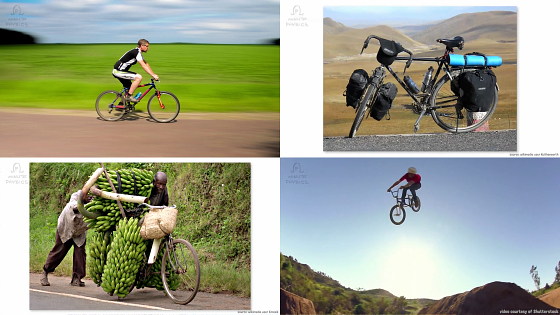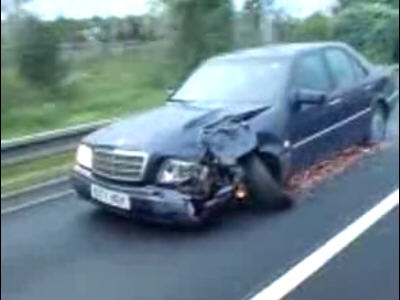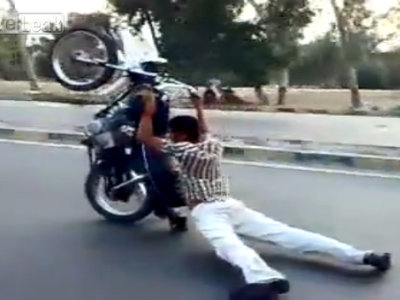Explain why bicycles can keep running without falling down, and the mechanism is explained with animation

Everyone is a bicycle riding like a matter of course, but there are a lot of people who felt horror as "when they first started riding, they could not ride without falling into such things". Although there are only two wheels, why the bicycle can run steadily, movies that clearly explain this are explained logically.
How Do Bikes Stay Up? - YouTube
Bicycles are familiar rides that many people have to melt into the lives of many people and have to indulge.

However, it is said that it is strange that "Why can a running bicycle keep running without falling down?" Bicycles pushed out by hand and given enough speed can keep running even if no one is on board.

According to the movie in America it is often "caused by the rotation of the wheelMoment of forceWheel stabilizes byLaw of conservation of angular momentumIt is said that it is misunderstood as "It depends on it."

This shows that making an experiment to fix the steering wheel makes a mistake. If the bicycle runs straight due to angular momentum preservation, the angle of the steering wheel should be irrelevant.

However, in fact it falls down like this quickly. Some people ride a bicycle say that "the tire becomes more stable as the diameter of the tire becomes bigger", and although angular momentum preservation seems to have nothing to do with the stability of the bicycle, at least the bicycle trying to collapse is rebuilt It seems to be said that there is not much power.

Also, another erroneous understanding is "because it has propulsive force in the forward direction". The idea is that the bicycle can continue straight ahead by positive energy going forward.

However, this also shows that this is not the case with simple experiments. Pushing the running bicycle from the side in this way ......

I will change the direction and continue running. If only the propulsion force in the forward direction is affecting the stability, the car body should fall down at the moment the steering wheel is broken, so it seems to be said that this is also a meaningless theory.

With an actual bicycle, if the car body tilts in either direction, the front wheels will break in the same direction, causing the work to return the car body to the center.

As a result of this, the body that was being tilted returns to its original position, which can occur continuously so that the bicycle can continue running without collapsing.

There are three main mechanisms working here.

The front fork that supports the front wheel of the bicycle is mounted with such an angle (white solid line). This angle is "Caster angleIt is called "Offset" which is a positional difference between the place where the axis of the front fork is extended (white line) and the place where the wheel actually touches the ground (red arrow). With this offset, the tilt of the car body creates a break angle on the front wheels.

When the car body tilts to the left as shown in the image below, the difference between the ground contact point of the tire and the imaginary ground contact point of the shaft creates a force to bend the handle further to the left.

The bicycle that the handle turns too far and turns to the left works with the force pulled back to the outside, that is to the right side, by the centrifugal force. This balance of force continues to occur, so the bicycle can run consistently.

Also, it is important that the axis of the front fork (white line) and the center of gravity of the steering wheel and tire (black and white circle) are slightly misaligned.

Because heavy loads are located in front of the shaft of the fork, weight is applied to the inside when the car body tilts, and as a result, there is a force to cut the handle inward.

It is also true that the "gyroscopic effect" caused by the rotation of the wheels is working, but it is assumed that the bicycle does not collapse as it is trying to maintain the standing state of the rotating wheel It is a little different from theory.

It is very easy to understand when you rotate the wheel with your hand, but the gyroscopic effect appears most vigorously when you apply a force of 90 degrees to the axis. Even if you attempt to raise it vertically by applying force like a red arrow, the wheels do not try to rise, instead they will show a movement that changes the orientation of the tire around the axle.

The same thing can be said for a bicycle. If you turn the bicycle which rotated the front wheel to the right and left, the gyroscope effect causes the wheel itself to cut the steering wheel, and by combining it with the force of the caster angle mentioned above, the handle is cut inward.

In other words, the bicycle can run steadily by three of "caster angle", "center of gravity of the front wheel" and "gyro effect".

In order to run steadily, it is necessary that a sufficient speed is added. If the speed is slow, it falls like this in this way.

Also it is not good to run in the opposite direction. When pushing the bicycle with the handle behind, the bicycle falls in an instant in a state that it is not stable at all.

These three are working closely to realize the stability of the bicycle, but it is strange that it is not necessarily that three must be complete.

The bicycle for this experiment is made to offset the gyro effect of the wheel, has a special structure that the ground contact point of the front wheel is before the caster, and the body which stability seems unlikely to be hoped for.

However, even if it is extruded by hand, it can run without collapsing.

Moreover, this body is a special bicycle that the steering mechanism is equipped on the rear wheel. This looks like it looks to be unstable, but it looks like I can run without problems in practice.

Indeed more elements are hidden in the stability of the bicycle. For example, this bicycle has a weight attached to the back of the front fork and moves the center of gravity backward to eliminate stability. Although it seems that it will not be able to run properly as it is ... ...

Driving by human beings will create stability. In other words, human beings are one of the factors that generate stability.

In this way, the fact that the bicycle can run without collapsing is not caused by specific factors such as "gyroscopic effect" or "caster angle", but rather the stability obtained by complicated involvement of various factors It will be done.

Looking at this movie, "However, there may be cases where the wheel that is out of the bicycle continues to roll as a single unit, in that case, there is no concern about casters or center of gravity," some people may have doubts. That may be another problem, which means that there is a different mechanism.
Related Posts:







